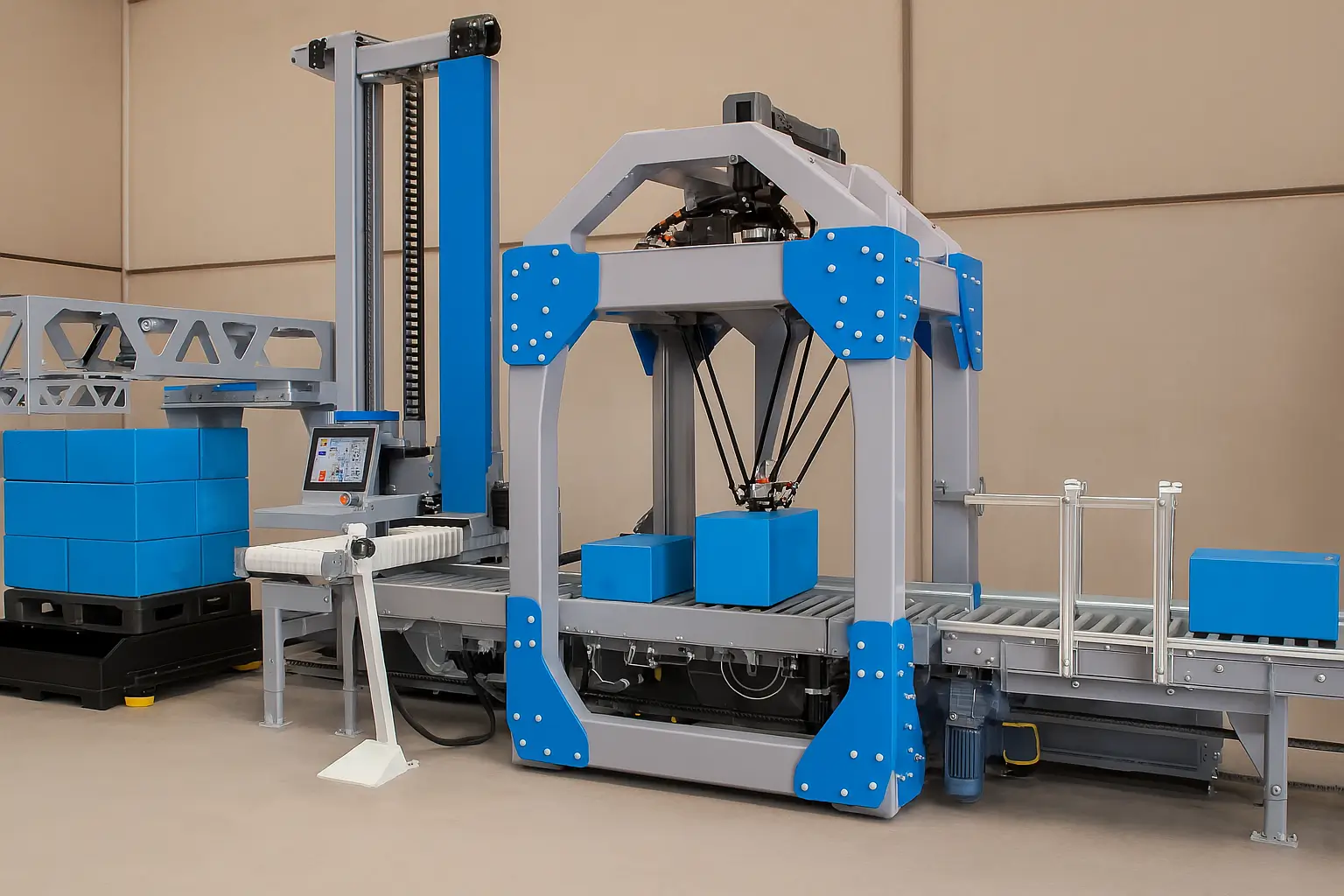Layer palletizing is an advanced automated process used in logistics and warehousing. It stacks products in layers on pallets.
This method helps with efficient storage and transportation. This method changes how we prepare goods for shipment. It focuses on stability, space savings, and efficiency. The technology blends mechanical systems and programmable controls. This creates secure, uniform pallet loads.
These loads can handle the demands of transportation while also maximizing storage space. Automation is changing supply chain operations. Layer palletizing is now a key solution. It helps with labor shortages, boosts workplace safety, and increases productivity. This technology benefits many industries, including food, beverage, pharmaceuticals, and manufacturing.
Definition and Fundamental Concepts of Layer Palletizing
Core Principles and Methodology
Layer palletizing is an automated process. It arranges products in horizontal layers. Then, it places them on a pallet for storage or shipping.
This system aims to prepare goods for transport efficiently. It also seeks to make the most of the available space.
This technique groups products by layer before moving them to a pallet. This way, the arrangement stays stable and uniform during logistics.
This method is different from traditional pick-and-place palletizing. It focuses on complete layers instead of single items. This change leads to higher throughput and more consistent pallet formation.
Layer palletizing is key to improving the supply chain. It creates standardized and secure pallet loads. These loads are easy to handle, store, and transport through different distribution channels.
Layer Building Process
The layer building process includes sorting and organizing. It aims to maximize space on a pallet. This helps place cases in set patterns efficiently.
This process usually happens at a special build station. Here, products are set into complete layers. Then, they are moved to the pallet. This often uses vacuum end-of-arm tools linked to a palletizing robot.
The system neatly arranges products in rows. Then, it pushes them aside to make another row. This continues until a full layer is formed.
This method uses space well. It keeps products safe and creates stable loads.
The items in each layer are arranged in patterns. These patterns help interlock products and evenly distribute weight.
After layers form, they stack onto the pallet one by one until the right height or shape is reached.
Types of Layer Palletizing Systems
High-Infeed and Low-Infeed Layer Palletizers
Layer palletizing systems have two main types: high-infeed (top entry) and low-infeed palletizers.
In high-infeed layer palletizing systems, the pallet moves up and down. Meanwhile, layers are created and transferred from above.
After a layer forms, the pallet goes down to take the next layer. This keeps happening until it reaches the target height with the right number of layers.
This design works well for handling cartons, trays, and shrink packs. It allows for gentle placement from above. Low-infeed palletizers provide ground-level solutions. They are easy to access and don’t need extra stands or platforms. Choosing between high and low-infeed systems depends on a few key factors.
Conventional Layer Palletizers vs. Robotic Palletizing Systems
Palletizing technology has two main types: conventional layer palletizers and robotic palletizing systems. Each type works differently and suits various needs.
They provide great speed and high throughput for uniform loads.
These systems are designed for busy production lines. They work best when product sizes stay the same and pattern changes are few.
Robotic palletizing systems are more versatile and flexible. They can handle different SKUs and load types easily.
They easily adapt to various product sizes, weights, and packaging types. They are ideal for tasks that frequently switch products or require mixed loads.
Conventional systems are quick for similar products.
Working Principles of Layer Palletizing
Recipe-Based Layer Configuration
Layer palletizing uses recipe-based setups. Predefined stacking patterns are stored in the system for consistent use.
These recipes show how to build layers using the case and pallet sizes. This helps use space well and keeps the load stable.
The programming considers factors like case orientation, interlocking patterns, and weight distribution. This helps create efficient and secure pallet loads.
System operators can choose the right recipe for the product on the line. This automatically sets up the palletizer to use the correct stacking pattern.
This method enables fast switchovers between product types. It also keeps palletizing quality steady.
The recipe-based method allows for ongoing improvement. New patterns can be created and saved to adjust to changes in packaging or product sizes over time.
Mechanical Systems and Control Integration
Layer palletizing systems combine advanced control systems with physical parts. This setup ensures accurate handling and placement of products.
These systems usually use conveyors for product infeed. They have row-forming and layer-forming areas. Then, transfer mechanisms move complete layers onto pallets.
The control integration links these parts using programmable logic controllers (PLCs). These PLCs manage timing, positioning, and movement sequences.
In high-infeed systems, lifting platforms move pallets up and down as layers stack. Layer-forming areas neatly arrange products before they are transferred.
Combining these mechanical and control elements creates a smooth process flow. This boosts throughput and reduces the chance of product damage or system downtime.
Benefits and Advantages of Layer Palletizing
Operational Efficiency and Productivity Improvements
Layer palletizing boosts efficiency over manual methods. It greatly increases throughput and cuts down on labor needs.
These systems work automatically, so they can run all the time. Some can handle up to three layers each minute, which is much faster than doing it by hand.
Higher productivity means lower costs per unit and better facility throughput. This happens without raising labor expenses.
Layer palletizing at a build station saves a lot of time. This is especially true for high-volume operations, compared to old pick-and-place stacking methods.
A systematic approach removes variability in palletizing. This keeps cycle times consistent and output rates predictable.
A single robot with layer-handling skills can palletize four production lines at once. This boosts productivity in manufacturing operations.
Space Optimization and Logistical Benefits
Layer palletizing boosts space use in the supply chain. It makes evenly stacked pallets that maximize vertical storage. This method keeps loads stable too.
Arranging products in set patterns cuts down on wasted space. This helps use pallets better, so more products fit per shipment. As a result, transportation costs go down.
These space efficiencies help not just with palletizing. They also improve warehouse storage, shipping container use, and retail receiving operations.
Safety and Labor Considerations
Layer palletizing improves workplace safety by automating tough tasks. These tasks often create serious ergonomic risks for warehouse workers.
The technology eliminates repetitive lifting, bending, and twisting in manual palletizing. This change helps prevent musculoskeletal injuries and reduces worker compensation claims.
This automation is very useful in today’s tough labor market. Many organizations struggle to find and keep warehouse workers.
Machines can handle tough tasks. This lets companies assign skilled workers to roles that require thinking and problem-solving. Now, they focus on jobs that need their expertise, not just physical labor.
Reducing labor dependency helps stabilize operations. It lessens the effects of changes, absences, and turnover on important shipping tasks.
Also, using automated pallet construction boosts workplace safety. It lowers the chances of pallets collapsing or loads shifting while being handled.
Applications and Industry Implementation
Versatility Across Manufacturing Sectors
Layer palletizing technology has shown great flexibility in many manufacturing sectors. It is especially popular in food and beverage, pharmaceutical, and consumer goods industries.
Layer palletizers in food and beverage manufacturing quickly stack cases. They handle bottled drinks, canned goods, and packaged foods. They work fast and treat these fragile products gently.
Pharmaceutical manufacturers gain from automated layer palletizing systems. These systems provide precise product orientation for barcode scanning. They also help ensure regulatory compliance during distribution.
Consumer goods makers use layer palletizing. This helps them handle different package sizes and promotions. They can do this while keeping their operations efficient.
The technology isn’t just for core industries. It also applies to building materials, chemical products, and electronics manufacturing. It highlights the value for sectors handling packaged goods in distribution networks.
Integration with Broader Automation Systems
Modern layer palletizing systems now work as part of larger end-of-line automation systems. They no longer just stand alone.
These methods connect palletizing to packaging, conveyor systems, and automatic pallet dispensers. They also connect to stretch wrapping equipment. This setup creates smooth product flows from manufacturing to distribution preparation.
For example, advanced setups might use automatic tier sheet dispensers. This adds stability between layers. They can also connect with warehouse management systems. This helps optimize pallet setups for customer needs and destination details.
Advanced system integrations can include robotic depalletizing. These robots work alongside palletizing systems. This setup helps with efficient unpacking and repacking of products.
Useful Summarization Table
| Aspect | Description | Details / Examples |
|---|---|---|
| Definition | Automated process of stacking products in full horizontal layers on pallets | Organizes, sorts, and maximizes pallet space by placing cases layer by layer for efficient storage and transport. |
| Layer Building Process | Cases are arranged into rows and then combined into layers on a conveyor build station | Uses stops, bump turns, and conveyor speed control to position cases precisely before robot picks up the full layer. |
| Types of Systems | High-infeed (top entry) and Low-infeed (bottom entry) layer palletizers | High-infeed moves pallet vertically; low-infeed keeps pallet level and lifts layers from below. |
| Stacking Patterns | Various palletizing patterns to maximize stability and space utilization | Includes interlocked, partially interlocked, block, split block, brick, row, split row, and pinwheel patterns. |
| Benefits | Time-saving, improved efficiency, better space utilization, reduced labor, and increased safety | One robot can palletize multiple lines; recipes can be selected via HMI; stable loads reduce damage and improve transport safety. |
| Applications | Used in food & beverage, pharmaceuticals, consumer goods, manufacturing | Handles multiple case sizes and shapes; adaptable to high volume and product variety. |
| Automation Integration | Can be integrated with conveyors, pallet dispensers, stretch wrappers, and labeling systems | Enables seamless end-of-line automation from empty pallet feeding to secured pallet dispatch. |
| Key Components | Conveyor build station, vacuum end-of-arm tooling, palletizing robot, sensors, control system | Coordinates case orientation, positioning, layer formation, and pallet stacking with precision. |
| Pallet Load Stability | Achieved through optimized stacking patterns and sometimes intermediate layers (e.g., cardboard sheets) | Interlocking patterns enhance load security; column stacking maximizes strength; intermediate layers improve stability. |
| Process Steps | Product preparation, pallet selection, arrangement planning, stacking, securing, labeling, quality check | Ensures efficient, safe, and traceable pallet loads; software often assists in pattern planning |



Leave a Reply